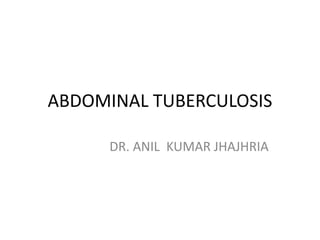
abdominaltb-160811131625 (2).pdf
- 1. ABDOMINAL TUBERCULOSIS DR. ANIL KUMAR JHAJHRIA
- 2. • The term abdominal tuberculosis includes tuberculous infection of the gastrointestinal tract, the mesentry, its nodes, and omentum, the peritoneum, and the solid organs related to the gastrointestinal tract, such as the liver and spleen. • Tuberculosis can involve any part of GI tract and is the sixth most common site of extra pulmonary involvement. • Chest X-rays show evidence of concomitant pulmonary lesions in less than 25 per cent of cases.
- 3. • Extra-pulmonary forms of TB which account for 10-15 per cent of all cases may represent up to 50 per cent of patients with AIDS. • TB of the gastrointestinal tract is the sixth most frequent form of extra- pulmonary site, after lymphatic, genitourinary, bone and joint, miliary and meningeal TB.
- 4. • There is a sharp contrast in the incidence of intestinal tuberculosis between the West and India: • 15 of 4222 patients admitted to the University of Michigan for tuberculosis had intestinal tuberculosis over a 22-year period, compared to 300 cases over 14 years in one Indian series, and 557 cases over 12 years in another series in similar number of patients. HISTORY- • Tuberculosis was recognized as early as the fourth century bc, and was known as phthisis, lupus, scrofula, or Pott's disease, until the identity was established by Robert Koch in 1882.
- 5. Some interesting facts about history- • Initially called CONSUMPTION( because of severe weight loss and the way the infection appeared to consume the patient),then, • WHITE PLAGUE- (Because of the extreme pallor seen among those infected) • IN ANCIENT TIMES- Existed 15000-20000 years ago. Among Egyptian mummies spinal TB called Pott’s disease has been detected by archaeologists. • IN MIDDLE AGES- called as King’s evil (was widely believed that the kings of England and France could cure scrofula simply by touching those affected.)
- 6. ETIOPATHOGENESIS- • The postulated mechanisms by which the tubercule bacilli reach the gastrointestinal tract are: (i) hematogenous spread from the primary lung focus in childhood, with later reactivation; (ii) ingestion of bacilli in sputum from active pulmonary focus; (iii) direct spread from adjacent organs; and (iv) and through lymph channels from infected nodes. • Abdominal tuberculosis is rare in the Western population and is declining in incidence in certain parts of India. • Strict control of tuberculosis in dairy herds and pasteurization of milk have almost eliminated bovine tuberculosis in many countries; however, despite efforts aimed at effective treatment of tuberculosis, the disease is not uncommon in developing countries.
- 7. • The earlier belief that most cases are due to reactivation of quiescent foci is being challenged with a recent study using DNA fingerprinting showing that 40 per cent cases are due to reinfection. In India, the organism isolated from all intestinal lesions has been Mycobacterium tuberculosis and not M.bovis.
- 10. • The tubercle bacillus is a Gram-positive, aerobic, non-motile, non-spore bearing organism, and it is identified by the Ziehl - Nelson acid-fast differential staining method. • The organism is cultured in Lowenstein - Jensen medium for 4 weeks. • Several other atypical or anonymous mycobacteria whose pathogenicity is not yet established have been identified. • The virulence of Mycobacterium tuberculosis is established by guinea-pig inoculation.
- 11. • Intestinal infection is more prevalent in populations from lower socioeconomic strata, contributing factors being poor hygiene, crowded living conditions and poor nutrition. • The incidence is higher in those with caseo- pneumonic and late disease than in those with fibrotic lesions or early disease.
- 18. • Tuberculous granulomas are initially formed in the mucosa or the Peyer’s patches. • These granulomas are of variable size and characteristically tend to be confluent, in contrast to those in Crohn’s disease. • Granulomas are often seen just beneath the ulcer bed, mainly in the submucosal layer. Submucosal oedema or widening is inconspicuous. • Tubercular ulcers are relatively superficial and usually do not penetrate beyond the muscularis.
- 19. • They may be single or multiple, and the intervening mucosa is usually uninvolved. • These ulcers are usually transversely oriented in contrast to Crohn’s disease where the ulcers are longitudinal or serpiginous. • Cicatrical healing of these circumferential 'girdle ulcers' results in strictures. Occlusive arterial changes may produce ischemia and contribute to the development of strictures. • Endarteritis also accounts for the rarity of massive bleeding in cases of intestinal tuberculosis
- 32. OTHER SIGNS- • Conical caecum- shrunken in size and pulled out of the iliac fossa due to contraction and fibrosis of the mesocolon. The hepatic flexure may also be pulled down. • Early involvement of the ileocaecal region manifesting as spasm and oedema of the ileocaecal valve. Thickening of the lips of the ileocaecal valve and/or wide gaping of the valve with narrowing of the terminal ileum (“Fleischner” or “inverted umbrella sign”) are characteristic.
- 33. • “String sign” – persistant narrow stream of barium indicating stenosis. • Purse string stenosis– localized stenosis opposite the ileocaecal valve with a rounded off smooth caecum and a dilated terminal ileum.
- 66. OESOPHAGEAL TB • Oesophageal tuberculosis is a rare entity, constituting only 0.2 per cent of cases of abdominal tuberculosis . • Oesophageal involvement occurs mainly by extension of disease from adjacent lymph nodes. • The patient usually presents with low grade fever, dysphagia, odynophagia and an ulcer, most commonly midoesophageal. • The disease usually mimics oesophageal carcinoma and extraoesophageal focus of tuberculosis may not be evident.
- 67. GASTRODUODENAL TB • Stomach and duodenal tuberculosis each constitute around 1 per cent of cases of abdominal tuberculosis. • Gastroduodenal tuberculosis may mimic peptic ulcer disease with a shorter duration of history and non response to anti-secretary therapy. It may also simulate gastric carcinoma. • Surgical bypass has been required in the majority of cases to relieve obstruction but successful endoscopic balloon dilatation of duodenal strictures has been reported.